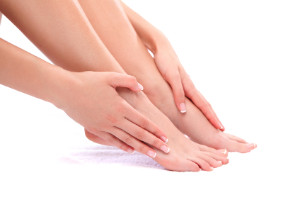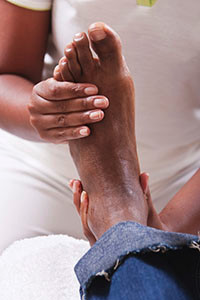

 Traveling can be exciting, but nothing can ruin a trip like foot pain. And that’s not all that you need to watch out for when jet setting. Sitting in a small airplane seat, especially on a long flight, can lead to cramping and discomfort. In order to avoid this, try to walk the aisles as much as you can and stretch frequently. Drinking plenty of water and doing your best to avoid alcohol is also a good tip to avoid the aches and pains of a flight. When you land, there’s a good chance that you’ll be doing some walking. Be sure to wear comfortable shoes to avoid blisters and swelling. Remember, you can’t take a vacation from your feet.
Traveling can be exciting, but nothing can ruin a trip like foot pain. And that’s not all that you need to watch out for when jet setting. Sitting in a small airplane seat, especially on a long flight, can lead to cramping and discomfort. In order to avoid this, try to walk the aisles as much as you can and stretch frequently. Drinking plenty of water and doing your best to avoid alcohol is also a good tip to avoid the aches and pains of a flight. When you land, there’s a good chance that you’ll be doing some walking. Be sure to wear comfortable shoes to avoid blisters and swelling. Remember, you can’t take a vacation from your feet.
Everyday foot care is very important to prevent infection and other foot ailments. If you need your feet checked, contact Dr. Alan J. Spector from Shore Podiatry. Our doctor can provide the care you need to keep you pain-free and on your feet.
Everyday Foot Care
Often, people take care of their bodies, face and hair more so than they do for their feet. But the feet are a very important aspect of our bodies, and one that we should pay more attention to. Without our feet, we would not be able to perform most daily tasks.
It is best to check your feet regularly to make sure there are no new bruises or cuts that you may not have noticed before. For dry feet, moisturizer can easily be a remedy and can be applied as often as necessary to the affected areas. Wearing shoes that fit well can also help you maintain good foot health, as well as making it easier to walk and do daily activities without the stress or pain of ill-fitting shoes, high heels, or even flip flops. Wearing clean socks with closed shoes is important to ensure that sweat and bacteria do not accumulate within the shoe. Clean socks help to prevent Athlete’s foot, fungi problems, bad odors, and can absorb sweat.
If you have any questions please feel free to contact our office located in Point Pleasant, NJ . We offer the newest diagnostic and treatment technologies for all your foot and ankle needs.
 Ingrown toenails can be very painful to experience. Most common in teenagers, though fairly common in the greater population, an ingrown toenail is characterized by the toenail digging into and breaking the adjacent soft tissue. This can lead to infection if the breaks in the skin remain for too long. Treatment of ingrown toenails range from clipping the nail more appropriately to surgically removing the nail or even destroying the growth plate in the nail bed. For chronic sufferers these surgical options may be necessary. It is best to consult a podiatrist if you have ingrown toenails.
Ingrown toenails can be very painful to experience. Most common in teenagers, though fairly common in the greater population, an ingrown toenail is characterized by the toenail digging into and breaking the adjacent soft tissue. This can lead to infection if the breaks in the skin remain for too long. Treatment of ingrown toenails range from clipping the nail more appropriately to surgically removing the nail or even destroying the growth plate in the nail bed. For chronic sufferers these surgical options may be necessary. It is best to consult a podiatrist if you have ingrown toenails.
Ingrown toenails can become painful if they are not treated properly. For more information about ingrown toenails, contact Dr. Alan J. Spector of Shore Podiatry. Our doctor can provide the care you need to keep you pain-free and on your feet.
Ingrown Toenails
Ingrown toenails occur when a toenail grows sideways into the bed of the nail, causing pain, swelling, and possibly infection.
Causes
Prevention
Because ingrown toenails are not something found outside of shoe-wearing cultures, going barefoot as often as possible will decrease the likeliness of developing ingrown toenails. Wearing proper fitting shoes and using proper cutting techniques will also help decrease your risk of developing ingrown toenails.
Treatment
Ingrown toenails are a very treatable foot condition. In minor cases, soaking the affected area in salt or antibacterial soaps will not only help with the ingrown nail itself, but also help prevent any infections from occurring. In more severe cases, surgery is an option. In either case, speaking to your podiatrist about this condition will help you get a better understanding of specific treatment options that are right for you.
If you have any questions please feel free to contact our office located in Point Pleasant, NJ . We offer the newest diagnostic and treatment technologies for all your foot and ankle needs.
 Foot diseases and other foot-related problems often become more prevalent as we age. Years of bearing body weight and certain ailments can combine to wreak havoc on the feet and ankles. The foot problems we may experience as time goes on vary from minor to potentially very serious. First and foremost, if you are a diabetic, foot care needs to be a high priority. Diabetic ulcers and sores, if left untreated, can lead to infection and even gangrene, resulting in amputation. Daily foot inspections are necessary to ensure that there are no cuts, sores, or swelling. Even something as seemingly minor as cracked skin on the foot can lead to terrible consequences if gone unnoticed. Using moisturizer and soap that doesn’t dry out the skin can help in this area. That being said, it is also important to keep the feet dry, as toenail fungus grows more readily in moist environments. Keeping the feet elevated is also a good tip. This will help circulate the blood to the lower extremities. Poor circulation can lead to serious medical conditions.
Foot diseases and other foot-related problems often become more prevalent as we age. Years of bearing body weight and certain ailments can combine to wreak havoc on the feet and ankles. The foot problems we may experience as time goes on vary from minor to potentially very serious. First and foremost, if you are a diabetic, foot care needs to be a high priority. Diabetic ulcers and sores, if left untreated, can lead to infection and even gangrene, resulting in amputation. Daily foot inspections are necessary to ensure that there are no cuts, sores, or swelling. Even something as seemingly minor as cracked skin on the foot can lead to terrible consequences if gone unnoticed. Using moisturizer and soap that doesn’t dry out the skin can help in this area. That being said, it is also important to keep the feet dry, as toenail fungus grows more readily in moist environments. Keeping the feet elevated is also a good tip. This will help circulate the blood to the lower extremities. Poor circulation can lead to serious medical conditions.
If you need your feet checked, contact Dr. Alan J. Spector of Shore Podiatry. Our doctor will attend to all of your foot and ankle needs and provide you with quality treatment.
Geriatrics and Podiatry
When people age, some common issues that may occur are bone density loss, dry skin, poor circulation, and rough brittle nails. These issues may also affect your foot health if the necessary steps are not taken to alleviate the problems.
It is important to take care of your feet because feet that are injured or diseased can affect your overall health. Having painful feet hinders your ability to do daily activities or may decrease your willingness to do the things that you need to do.
Visiting Your Geriatrician
As we age, health problems become more likely, so it is essential to visit your doctor for check-ups to ensure that you are doing the best you can to take care of your health. It is recommended to check your feet frequently for any possible cuts, bruises, swelling, corns or any other irregularities.
Taking Care of Elderly Feet
Cracked or dry feet can be treated by applying moisturizer often. It is also important not to wear old socks because the older the sock is, the higher the possibility there will be that there is bacteria there. Wear fresh socks and make sure they fit properly.
Proper foot health means that you can have a more active lifestyle and you will not be bogged down by pain. Foot health also leads to good circulation, which is paramount for overall health.
If you have any questions, please feel free to contact our office located in Point Pleasant, NJ . We offer the newest diagnostic tools and technology to treat your foot and ankle needs.
 Students at an elementary school in Desert Hot Springs, California were found to have contracted the virus Coxsackie, also known as hand, foot, and mouth disease. As the disease is highly communicable, a notification was sent out to parents of the students that could be exposed. The symptoms are rashes and blisters in the mouth, on the palms of the hands, and on the soles of the feet. It might be difficult to walk and there is typically an accompanying fever. If you develop blisters on your feet it is important that you try to keep them from rupturing, as the disease is spread through the fluid.
Students at an elementary school in Desert Hot Springs, California were found to have contracted the virus Coxsackie, also known as hand, foot, and mouth disease. As the disease is highly communicable, a notification was sent out to parents of the students that could be exposed. The symptoms are rashes and blisters in the mouth, on the palms of the hands, and on the soles of the feet. It might be difficult to walk and there is typically an accompanying fever. If you develop blisters on your feet it is important that you try to keep them from rupturing, as the disease is spread through the fluid.
When dealing with systemic disease of the feet, it is extremely important to check the affected areas routinely so that any additional problems are caught quickly. If you have any concerns about your feet and ankles contact Dr. Alan J. Spector from Shore Podiatry. Our doctor will assist you with all of your podiatric needs.
Systemic Diseases of the Feet
Systemic diseases affect the whole body, and symptoms usually are displayed in the feet. This condition can make a patient’s ability to walk unbearable. Systemic diseases include gout, diabetes mellitus, neurological disorders, and arthritis.
Gout – is caused by an excess of uric acid in the body. Common symptoms include pain, inflammation, and redness at the metatarsal/phalangeal joint of the base big toe. Gout can be treated by NSAIDs to relieve pain and inflammation, and other drugs that lower the acid levels in the body.
Diabetes mellitus – is an increase in the level of blood sugar that the body cannot counteract with its own insulin. Failure to produce enough insulin is a factor in Diabetes.
Diabetes of the Feet
Diabetic Neuropathy – may lead to damaged nerves and affect the feet through numbness and loss of sensation.
Peripheral Vascular Disease – can restrict the blood flow to the feet, and often times lead to amputation of the feet.
If you have any questions please feel free to contact our office located in Point Pleasant, NJ . We offer the newest diagnostic and treatment technologies for all your foot and ankle needs.
 If you begin to notice redness or dry, scaly skin around the toes, you may be suffering from Athlete’s foot. This possibility is heightened when accompanied by foul odor, which is a sign of both bacteria and fungus abrading the skin of your feet. Avoid touching the feet and then touching the rest of your body, as Athlete’s foot is communicable through contact. Moist environments should also be avoided, and be sure to wear shoes when at the gym locker room. Many over-the-counter medications are available to treat Athlete’s foot. To determine what is suitable for your case, however, it is best to consult with your podiatrist.
If you begin to notice redness or dry, scaly skin around the toes, you may be suffering from Athlete’s foot. This possibility is heightened when accompanied by foul odor, which is a sign of both bacteria and fungus abrading the skin of your feet. Avoid touching the feet and then touching the rest of your body, as Athlete’s foot is communicable through contact. Moist environments should also be avoided, and be sure to wear shoes when at the gym locker room. Many over-the-counter medications are available to treat Athlete’s foot. To determine what is suitable for your case, however, it is best to consult with your podiatrist.
Athlete’s foot is an inconvenient condition that can be easily reduced with the proper treatment. If you have any concerns about your feet and ankles, contact Dr. Alan J. Spector from Shore Podiatry. Our doctor will treat your foot and ankle needs.
Athlete’s Foot: The Sole Story
Athlete's foot, also known as tinea pedis, can be an extremely contagious foot infection. It is commonly contracted in public changing areas and bathrooms, dormitory style living quarters, around locker rooms and public swimming pools, or anywhere your feet often come into contact with other people.
Solutions to Combat Athlete’s Foot
Athlete’s foot can cause many irritating symptoms such as dry and flaking skin, itching, and redness. Some more severe symptoms can include bleeding and cracked skin, intense itching and burning, and even pain when walking. In the worst cases, Athlete’s foot can cause blistering as well. Speak to your podiatrist for a better understanding of the different causes of Athlete’s foot, as well as help in determining which treatment options are best for you.
If you have any questions please feel free to contact our office located in Point Pleasant, NJ . We offer the newest diagnostic and treatment technologies for all your foot and ankle needs.
 North Korean leader Kim Jong Un was recently seen limping in public, possibly due to his history of suffering from tarsal tunnel syndrome. The condition arises from the compression of the tibial nerve in the foot. The occurrence itself happened during a broadcasted report on the leader’s inspection visit to North Korea’s Kangwon Province. Symptoms of tarsal tunnel syndrome include a burning pain at the sole of the foot, numbness, or tingling. Treatment for tarsal tunnel syndrome may include anti-inflammatory medications and orthotics.
North Korean leader Kim Jong Un was recently seen limping in public, possibly due to his history of suffering from tarsal tunnel syndrome. The condition arises from the compression of the tibial nerve in the foot. The occurrence itself happened during a broadcasted report on the leader’s inspection visit to North Korea’s Kangwon Province. Symptoms of tarsal tunnel syndrome include a burning pain at the sole of the foot, numbness, or tingling. Treatment for tarsal tunnel syndrome may include anti-inflammatory medications and orthotics.
Tarsal tunnel syndrome can be very uncomfortable to live with. If you are experiencing tarsal tunnel syndrome, contact Dr. Alan J. Spector of Shore Podiatry. Our doctor can provide the care you need to keep you pain-free and on your feet.
Tarsal Tunnel Syndrome
Tarsal tunnel syndrome, which can also be called tibial nerve dysfunction, is an uncommon condition of misfiring peripheral nerves in the foot. The tibial nerve is the peripheral nerve in the leg responsible for sensation and movement of the foot and calf muscles. In tarsal tunnel syndrome, the tibial nerve is damaged, causing problems with movement and feeling in the foot of the affected leg.
Common Cause of Tarsal Tunnel Syndrome
The Effects of Tarsal Tunnel Syndrome
A physical exam of the leg can help identify the presence of tarsal tunnel syndrome. Medical tests, such as a nerve biopsy, are also used to diagnose the condition. Patients may receive physical therapy and prescriptive medication. In extreme cases, some may require surgery.
If you have any questions please feel free to contact our office located in Point Pleasant, NJ . We offer the newest diagnostic and treatment technologies for all your foot and ankle needs.
 If you are experiencing moderate to severe pain in your heel or foot, you may have Plantar Fasciitis. Plantar Fasciitis is an inflammatory condition that affects the heel of the foot, causing in some cases, very extreme pain. There are many causes for this, one being overstretching of the plantar fascia ligament, which runs from the heel to the ball of the foot. This ligament supports the arch and can be affected by both the feet below it, and the muscles above. If the calf muscles are too tight, this can pull on the ligament and cause inflammation. A similar thing happens if you have flat feet. The foot stretches the ligament from below. Other activities that can cause Plantar Fasciitis are standing for long periods of time, running while planting your heel instead of your toe, and constant stress on the plantar fascia ligament. Make sure to stretch your calves, take care that your footwear is not worn out, and seek podiatric treatment if your condition is painful.
If you are experiencing moderate to severe pain in your heel or foot, you may have Plantar Fasciitis. Plantar Fasciitis is an inflammatory condition that affects the heel of the foot, causing in some cases, very extreme pain. There are many causes for this, one being overstretching of the plantar fascia ligament, which runs from the heel to the ball of the foot. This ligament supports the arch and can be affected by both the feet below it, and the muscles above. If the calf muscles are too tight, this can pull on the ligament and cause inflammation. A similar thing happens if you have flat feet. The foot stretches the ligament from below. Other activities that can cause Plantar Fasciitis are standing for long periods of time, running while planting your heel instead of your toe, and constant stress on the plantar fascia ligament. Make sure to stretch your calves, take care that your footwear is not worn out, and seek podiatric treatment if your condition is painful.
Plantar fasciitis can be very painful and inconvenient. If you are experiencing heel pain or symptoms of plantar fasciitis, contact Dr. Alan J. Spector from Shore Podiatry. Our doctor can provide the care you need to keep you pain-free and on your feet.
What Is Plantar Fasciitis?
Plantar fasciitis is the inflammation of the thick band of tissue that runs along the bottom of your foot, known as the plantar fascia, and causes mild to severe heel pain.
What Causes Plantar Fasciitis?
How Can It Be Treated?
While very treatable, plantar fasciitis is definitely not something that should be ignored. Especially in severe cases, speaking to your doctor right away is highly recommended to avoid complications and severe heel pain. Your podiatrist can work with you to provide the appropriate treatment options tailored to your condition.
If you have any questions please feel free to contact our office located in Point Pleasant, NJ . We offer the newest diagnostic and treatment technologies for all your foot and ankle needs.